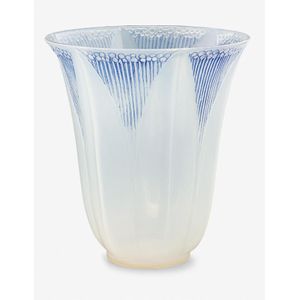Rene Lalique Damiers Vase, 1935 Design
You must be a subscriber, and be logged in to view price and dealer details.
Subscribe Now to view actual auction price for this item
When you subscribe, you have the option of setting the currency in which to display prices to $Au, $US, $NZ or Stg.
- Patination / Patina - In broad terms, patination refers to the exterior surface appearance of the timber, the effect of fading caused by exposure to sunlight and air over the course of a century or more, changing the piece to a soft, mellow colour.
As patina is very difficult to replicate, it is one of the most important guides to determining the age of furniture.
Patina is also the term applied to the bloom or film found on old bronzes due to oxidisation. - Acid Etched - Acid etching is often used on glass, metals, and stone to create decorative finishes or to prepare the surface for further treatment or coating. The process of acid etching involves applying an acidic solution, such as hydrochloric acid or nitric acid, to the surface of the material and allowing it to react with the surface. The acid etches away a thin layer of the material, creating a rough, uneven finish. Acid etching can be used to create a variety of different finishes, from a subtle matte finish to a more pronounced, textured finish.
- Etched - Glass decorated with an etched design, which is achieved through marking out the pattern, protecting the area that is not be etched, and then immersing the object in acid to dissolve the surface of the unprotected area. With some glass objects, such as cameo glass, there may be several layers of different coloured glass, and part of the top layer is dissolved leaving the bottom layer as the background. The longer the time of exposure of the object to acid, the deeper the etching.
The word etching is also sometimes used to describe another method of decoration, where wheel grinders were used decorate the surface, but this technique is usually known as engraving.
This item has been included into following indexes:
Visually similar items

A Rene Lalique opalescent and blue stained glass vase, in the Cytise pattern, tapering conical shape on slightly spreading foot, the walls moulded with seven encircling chevron ribs. Etched mark R. Lalique, France'. Height 12.7 cm

A Rene Lalique Ajaccio vase, designed 1938, the flared cylindrical body moulded to the lower section with gazelles at rest beneath a starry sky, in frosted and opalescent glass, acid etched R. Lalique France, 20 cm high. Provenance: Renee Antiques, New Yor

A Rene Lalique Ibis vase, designed 1934, the flared upper section in clear glass, above a blue grey patinated lower section, relief moulded with a repeating design of Ibises wading amongst reeds, inscribed R. Lalique France, 23 cm high. Provenance. Private

Rene Lalique, Campnanule', opalescent glass vase, R Lalique impressed mark to the base. Height 15 cm
